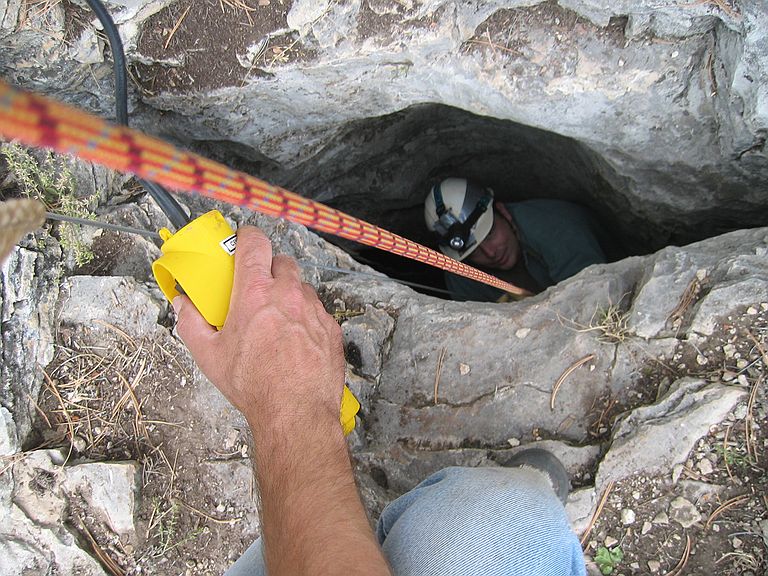|
The Western Interior Paleontological Society (WIPS) and Pennsylvania State's Earth & Mineral Sciences Museum conducted another excavation in 2004 of fossil mammals from caves in the Black Hills of southwestern South Dakota. The caves are known as "Parker's Pit" and "Don's Gooseberry Pit". The 11-day trip was a great success with approximately 100 bags of material being removed that ranged from 8-24 lbs. each. This may sound like a lot, but we barely scratched the surface of the cave debris cone being excavated. And, there are at least three other debris cones in this cave that may provide data of older fauna.
Entrance to Parker's Pit is from a sink hole in the ground approximately 50 cm wide (20 inches) at the top. It narrows and widens before reaching bottom, some 13.8m (45 ft) below the surface entrance. There are two main rooms below the surface. One is approximately 7-8m (23-26 ft). Below that is the "big" room which is approximately 32m (105 feet).
On this trip, we noticed another very small room below the main room. Access requires a tight crawl through a muddy channel. The debris cone from a previous entrance is covered with flowstone which may indicate even older material. This debris cone had been cracked by natural cave dynamics (material falling from the roof of the cave) which allowed us to take a sample from underneath the flowstone. Background: The Black Hills
are known as the "Island in the Plains" - they rise up as rugged
mountains in the middle of an expanse of grass in all directions.
Some mammals were isolated on this Island following the latest glaciations.
This, along with the uplift of the Rocky Mountains, isolated the Black
Hills in an environment totally surrounded by grasslands. How many
species can be supported on this island? Even 10 cm of sediment in
a cave can represent 2000+ yrs of history. It may be true that the
fauna being recovered today in caves represent species that existed in
a similar or warmer environment. A warmer environment was experienced
during the last interglacial time (between the last glacial period and
the glacial period before that.... or, approximately 125,000 years ago).
Cave debris cones: Parker's Pit & Don's Gooseberry Pit: Some mammals met an unfortunate fate at the bottom of these caves. They may have fallen in while being chased by predators or by falling through thin snow and ice covering the cave openings. Dust and dirt also fall into the caves as a result of wind and precipitation. What paleontologists find in such caves are "cones of debris" with intermixed bones, rocks, dust, dirt and cave flowstones. These "cones" will eventually reach from the base of the cave all the way up to the opening, thus sealing off the cave. In Parker's Pit, the original entrance appears to have been sealed in this manner. We enter the cave through another narrow opening (shown above). So, the "debris cone" we are excavating is a cone that sealed a previous entrance. It is often very difficult to locate a cave that has been sealed off by its cone of debris. Once sealed, modern dirt, rocks and plants further conceal its entrance. We have not located the top of the cone which sealed the main entrance to Parker's Pit. Conversely, at Don's Gooseberry Pit (located very near Parker's Pit), the top of the debris cone was found. The namesake of this cave is indicative of how it was found. Gooseberry bushes require a more moist soil than that typically found in the Black Hills. Don Brandborg found this cave while walking around the area near Parker's Pit. He noticed a Gooseberry bush and wondered why it would be growing there. Could it be a moist soil environment provided by a cave? After digging around a bit, he decided there may be something underneath the bush. So, after ecologically relocating the bush, he began digging and immediately found a treasure of bones. Further study is required, but it is believed that the bones being recovered today from this pit are modern. But, as we dig deeper into the pit in future years, the age of the bones will get older and older. We cannot know how deep this pit will go, but it will provide an excellent history of Black Hills mammals from the present to the age of the bottom of the pit. Another interesting phenomenon with such caves is that the deeper you dig, the more likely you are to find larger animals. As the debris cone nears the surface, most large animals will easily escape, only smaller rodents will be trapped. The entrance to Don's Gooseberry Pit is too small to expect large animal finds. Because the entrance to Parker's Pit hasn't been located, it's unknown whether or not we will find larger mammals.
Fun side
trips: Anyone participating in future Parker's Pit and Don's Gooseberry
Pit digs should know that there are plenty of activities and sightseeing
adventures for family members in the immediate area (e.g. Mt. Rushmore,
Custer State Park, Black Hills Institute, Badlands N.P., The Mammoth Site).
During this time of year, Custer State Park is known for its annual buffalo
(bison) round-up. It's an amazing site to watch horseback riders
round up bison from the park.
Collaborative institutions and key contacts:
References: (1) Russell Graham Pennsylvania State University Director and Associate Professor Earth and Mineral Sciences Museum and Department of Geosciences Email: rgraham@ems.psu.edu (2)
Angela
Matthias
(3)
Eric
C. Grimm
(4) Parker's Pit images from other WIPS member's websites
If you find
any errors, please contact Steve Wagner.
|



